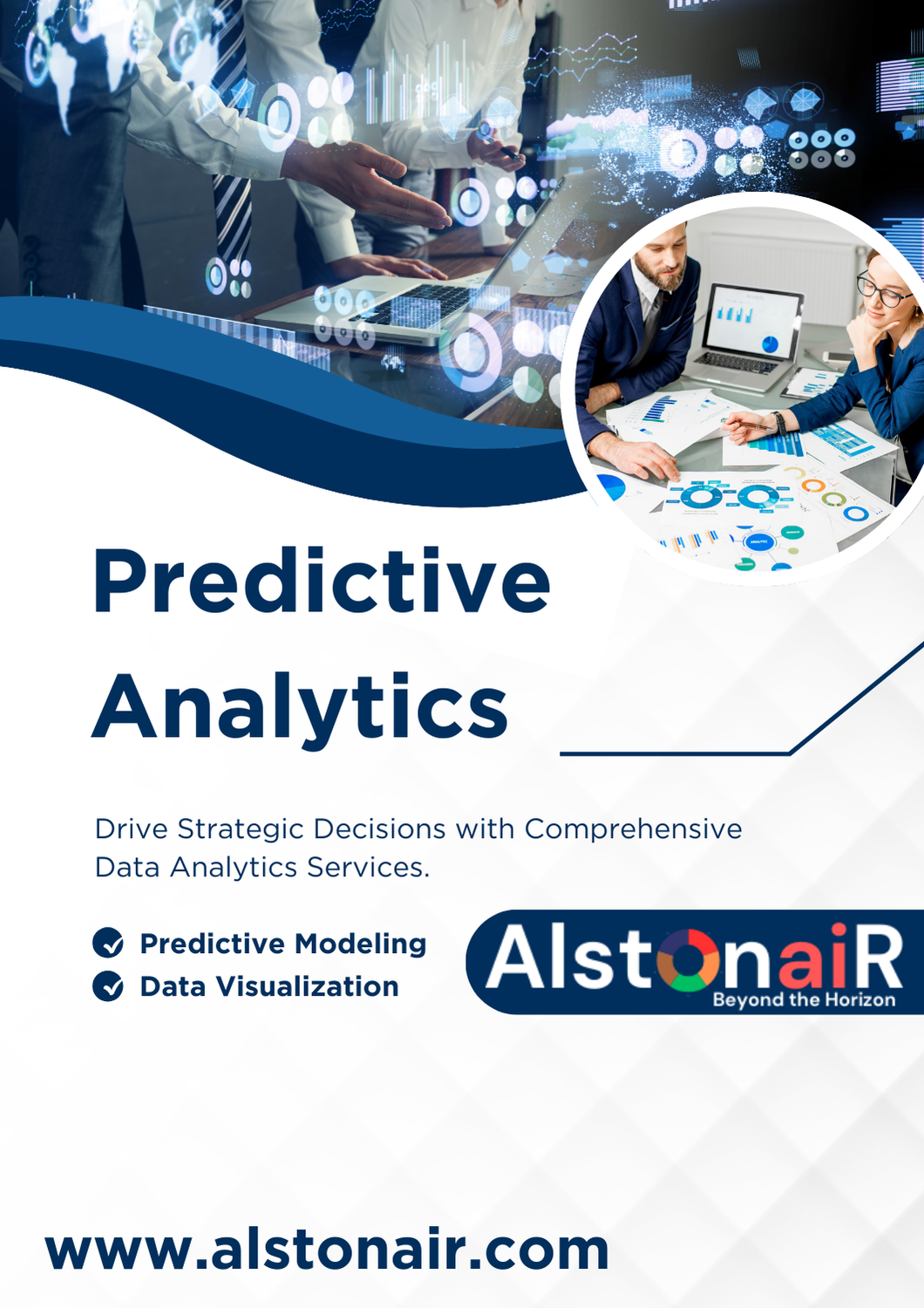The Predictive Analytics Software Application: Empowering Businesses
with Data-Driven Foresight
In today's dynamic business landscape, the ability to anticipate future trends and make informed decisions is crucial for success. The Predictive Analytics Software Application provides businesses with the power of data-driven insights, enabling them to forecast future outcomes, optimize operations, and gain a competitive edge.
This powerful application leverages cutting-edge machine learning algorithms and sophisticated statistical techniques to analyze historical data and uncover hidden patterns.
By identifying these patterns, the application can predict
future trends, allowing organizations to:
Forecast
Future Trends: Accurately predict market demand, sales figures, customer
behavior, and other key business metrics. This foresight allows for proactive
planning and resource allocation.
Optimize
Decision-Making: Make data-backed decisions based on predicted outcomes,
minimizing risks and maximizing opportunities. This leads to more effective
strategies and improved business performance.
Drive
Operational Efficiency: Identify areas for improvement in processes, resource
allocation, and operations. By predicting potential bottlenecks or inefficiencies,
businesses can implement proactive adjustments to streamline operations and
reduce costs.
Detect
Anomalies:
Identify unusual patterns or outliers in data that may indicate potential
problems or opportunities. This early detection allows for timely intervention
and prevents potential losses.
Key
Features and Benefits:
Advanced
Machine Learning: Utilizes state-of-the-art machine learning algorithms to
uncover complex relationships in data and generate accurate predictions.
Statistical
Techniques:
Employs proven statistical methods to ensure the reliability and validity of
predictions.
User-Friendly
Interface:
Provides an intuitive and easy-to-navigate interface, making it accessible to
users of all technical backgrounds.
Customizable
Dashboards and Reports: Allows users to create customized dashboards and reports to
visualize data and track key performance indicators.
Data
Integration: Seamlessly integrates with existing data sources, ensuring a
smooth and efficient data analysis process.
Target Audience:
This application is ideal for businesses of all sizes across
various industries, including:
Retail
Finance
Healthcare
Manufacturing
Supply Chain Management
Conclusion:
The
Predictive Analytics Software Application empowers businesses to move beyond
reactive decision-making and embrace a proactive, data-driven approach. By
harnessing the power of predictive analytics, organizations can gain valuable
insights, optimize their operations, and achieve sustainable growth in today's
competitive market.
Let's outline the development of a predictive analytics software
application focused on market demand, sales, customer behavior, and optimized
decision-making.
I.
Core Components:
Data
Ingestion & Management:
Data Sources: CRM (Customer
Relationship Management), ERP (Enterprise Resource Planning), POS (Point of
Sale), marketing automation platforms, social media, market research data,
economic indicators, weather data, etc.
Data Storage: Cloud-based data warehouse (e.g., Snowflake,
BigQuery, AWS Redshift) or on-premise solutions. Scalability and security are
crucial.
ETL (Extract, Transform, Load): Robust ETL pipelines to clean,
transform, and prepare data for analysis. This includes handling missing
values, outliers, and data type conversions.
Predictive
Modeling Engine:
Algorithms:
Time Series Analysis: ARIMA, Prophet (for forecasting trends and
seasonality).
Regression: Linear, multiple, polynomial (for predicting sales
based on various factors).
Classification: Logistic regression,
support vector machines, random forests (for customer segmentation and churn
prediction).
Clustering: K-means, DBSCAN (for
identifying customer groups with similar behavior).
Neural
Networks:
Deep learning models for complex patterns and high-dimensional data.
Model
Selection & Training: Automated model selection based on performance metrics (e.g.,
RMSE, MAE, accuracy, F1-score). Regular retraining and model updates are
essential.
Model
Deployment:
Containerization (Docker) and orchestration (Kubernetes) for scalable and
reliable model deployment.
Business Intelligence & Visualization:
Dashboards: Interactive dashboards
to visualize key metrics, forecasts, and insights.
Reports: Customizable reports
for different stakeholders.
Data
Exploration: Tools for users to explore data and identify trends.
Alerts
& Notifications: Automated alerts for significant changes in metrics or
potential risks.
Decision Optimization Module:
Scenario Planning: Allow users to create different scenarios and see their
potential impact on key metrics.
Resource
Allocation Optimization: Algorithms to optimize resource allocation based on predicted
demand and business constraints.
Recommendation
Engine:
Provide recommendations for pricing, marketing campaigns, inventory management,
etc.
II.
Technology Stack:
Programming
Languages:
Python (for data science and backend), JavaScript (for frontend).
Data
Science Libraries: Pandas, NumPy, Scikit-learn, TensorFlow/PyTorch, Statsmodels.
Database: PostgreSQL, MySQL, or
cloud-based data warehouse.
Cloud
Platform:
AWS, Google Cloud, Azure.
Frontend
Framework:
React, Angular, Vue.js.
BI Tools: Tableau, Power BI, or
custom dashboards.
III.
Development Process:
Requirements
Gathering:
Define specific business needs and use cases.
Data
Assessment:
Analyze available data and identify potential data gaps.
Data
Preparation: Clean, transform, and prepare data for modeling.
Model
Development & Training: Develop and train predictive models.
Model
Evaluation & Validation: Evaluate model performance and validate results.
Deployment
& Integration: Deploy models and integrate with existing systems.
Monitoring
& Maintenance: Monitor model performance and retrain as needed.
IV.
Key Considerations:
Data
Quality:
Accurate and consistent data is crucial for accurate predictions.
Scalability: The application should
be able to handle large volumes of data and increasing user demand.
Security: Protect sensitive data
and ensure compliance with relevant regulations.
Explainability: Provide insights into
how predictions are made to build trust and understanding.
User
Experience:
Design a user-friendly interface that is easy to navigate and understand.
Example
Use Cases:
Retail: Predict demand for
specific products and optimize inventory levels.
Finance: Forecast loan defaults
and identify high-risk customers.
Marketing: Predict customer churn
and optimize marketing campaigns.
Manufacturing: Predict equipment
failures and optimize maintenance schedules.
Conclusion:
The
Predictive Analytics Software Application is a powerful tool that empowers
businesses to move from reactive to proactive decision-making. By leveraging
advanced machine learning algorithms and statistical techniques, this
application helps organizations forecast trends, optimize operations, and
enhance decision-making. Whether it's predicting market demand, analyzing
customer behavior, or identifying operational inefficiencies, the insights
gained from predictive analytics drive smarter strategies and improve overall
business performance.
With a
user-friendly interface, customizable dashboards, and seamless data
integration, this solution is designed for businesses across various
industries, including retail, finance, healthcare, manufacturing, and supply
chain management. As companies continue to seek ways to stay competitive in an
ever-evolving market, predictive analytics becomes a crucial asset for
sustained growth and success. The future is data-driven, and businesses that
embrace predictive analytics will gain the foresight necessary to thrive in
today's fast-paced, data-rich environment.